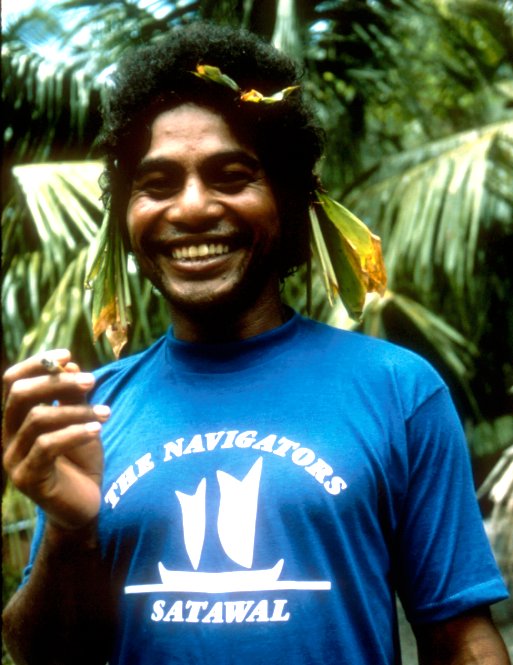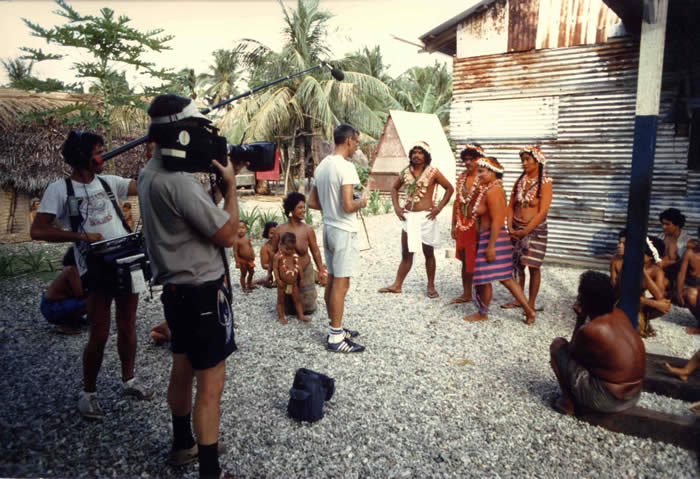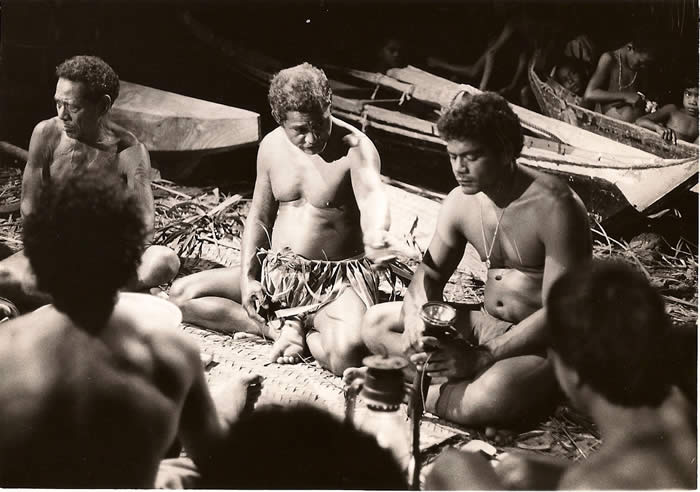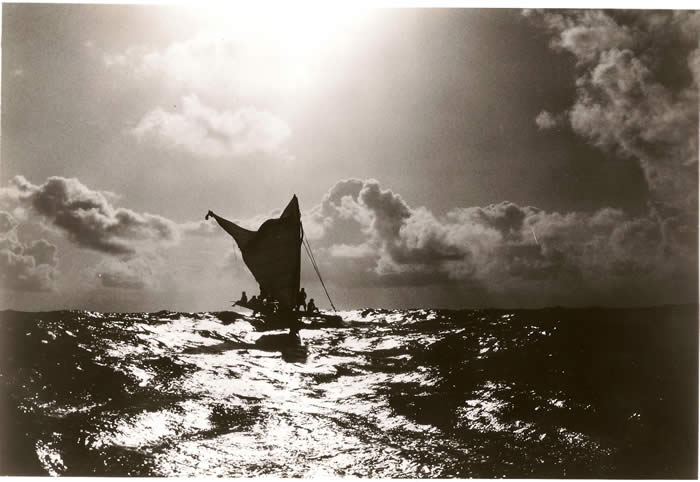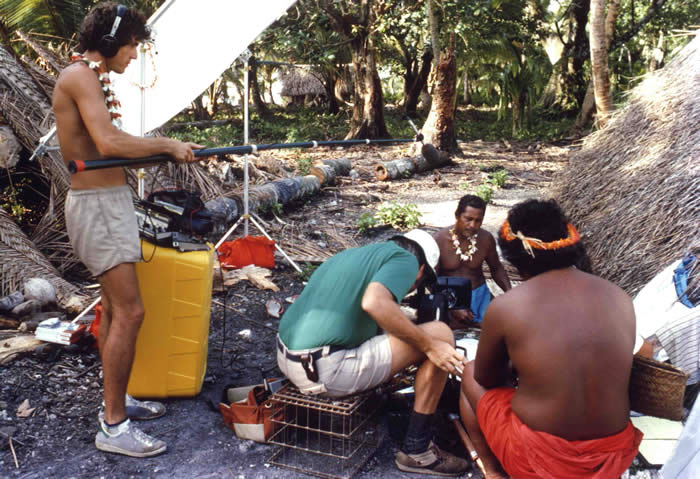
|
|
|
The Navigators - Reviews and Press Clippings The Navigators was shown in prime time on PBS in the United States, on the BBC in England and other venues in France, Sweden, Italy and around the world.
Mau's son on Satawal "The Navigators - Pathfinders of the Pacific" - was first shown nationally in prime time on PBS in 1983 and later broadcast internationally in Europe and South America. It was awarded a Cine Golden Eagle, a Blue Ribbon at the American Film Festival and a Silver Anvil and has been screened at the Massachusetts Institute of Technology film series, Film/Video International at Castle Hill, Honolulu Film Festival, Margaret Mead Film Festival, Nantes Festival International de film du Mer, among other venues.
Filming wedding on Stawal Here
are some press comments about The Navigators: "The Navigators (is) a fine documentary which describes the exploration and settlement of ancient Polynesia by navigated voyages more than a thousand years ago - six centuries before Columbus discovered America." "Using only the wind, stars, flights of birds and other natural signs to guide them, the ancestors of today's Polynesians sailed their 100 foot long, double hulled canoes across an area larger than Europe and North America combined on voyages that lasted for months. This fascinating documentary was made by Sam Low with the help of Mau Piailug, one of the last remaining palu, the non-instrument navigators of the Caroline Islands of Micronesia." San Francisco Chronicle.
Mau Piailug teaching navigation in his canoe house "THE NAVIGATORS, exploring the navigational voyages of Polynesians more than a thousand years ago - six centuries before Columbus sailed to America. According to legend, Hawaiians, Tahitians and Maoris are one people, their ancestors having sailed for months before settling the widely scattered islands of the South pacific. Early Polynesians - using the wind, stars, flights of bird and other natural signs - guided their canoes across an ocean larger that Europe and North America combined. These voyages are detailed by producer Sanford Low who has recorded oral traditions of the seafaring people of the atoll of Satawal in the central Caroline Islands. He also chronicles the passing of ancient navigational knowledge by palu (navigator) Mau Piailug to his people. But as Piailug sadly reflects: "After me, I am afraid there will be no more navigators." T.V. Guide - Close up. "…the first major film to treat the subject of Oceanic voyaging and navigation… "The navigators, combining first-rate cinematography with an accurate portrayal of the most recent findings in Polynesian archeology and anthropology, brings the saga of their Polynesian voyagers alive." Dr. Patrick Kirch, Bernice P. Bishop Museum, Honolulu. "A beautifully photographed, carefully organized program…" Boston Herald.
Mau Piailug's canoe at sea off Satawal Steve Thomas Photogarph "…consider Mau Piailug. Among sailors he is a John Glenn, a Chuck Yeager, even a Flash Gordon. He lives on Satawal, a Micronesian island 400 miles north of New Guinea, and he is a navigator. Using only his head and the lore therein, he guides canoes over open ocean to tiny days-distant destinations. His compass consists of sets of reference stars, his steering guides are the swells, his current indicators are wave shapes, bird and fish life are his markers, he dead-reckons by moving his destination toward him. In 1976, Piailug piloted the great canoe Hokule'a unerringly from Hawaii to Tahiti some 2800 miles away. He used no instruments." Sail Magazine "This is an excellent film about traditional canoe navigation in the Pacific that I highly recommend to both general audiences and students of anthropology, geography, and maritime history." "Over a half century ago Robert Flaherty brought the remarkable Nanook to world attention. In this film Sanford Low brings us the equally engaging Mau Piailug." American Anthropologist, the journal of the American Anthropological Association. "Technically this is a superb film employing an effective combination of "live" sequences, animation and interviews. It achieves a level of human involvement not usually found in archeological documentaries, mainly by focusing on the abilities and attitudes of Mau Piailug, a traditional navigators from Satawal." "…State-of-the-art presentation…" "…this may be our last chance to see this tradition (of seafaring) alive and performing under circumstances that approximate pre-European conditions. If this is the case, we can all be grateful to the makers of this film for preserving a record of Micronesian seamanship in a manner that renders it accessible to general audiences as well as students and scholars of archeology. It is certainly one of the best new films available in the field of archeology and should be seen by anyone interested in the subject." Archeology magazine. "One of the greatest seafaring feats of human history has been recreated in a documentary film about an island tribe in Micronesia. In his film, The Navigators, to be shown tonight on PBS, anthropologist Dr. Sanford Low demonstrates how the ancient Polynesians traveled thousands of miles in canoes to Tahiti and Hawaii using only the stars, winds and waves to guide them." New York Tribune. "On behalf of the people of the Federated States of Micronesia I would like to extend our heartfelt thanks to you and your crew for your recreation of this part of our culture which is dying out in this day and age of modern technology. I only hope that our young people will look upon this as a chance to grow into this modern age without forgetting our Micronesian traditions: those traditions which will keep our failing culture alive." Tosiwo Nakayama, President, federated States of Micronesia.
Filming interview with Mau Piailug |
Sam Low.com home | Biography | Library | Gallery | Screening Room | Forbears | Notebook | Contact Sam
Site, text, and images Copyright © 2002 Sam Low. All rights reserved. Any or all content may not be used without Sam's permission.
